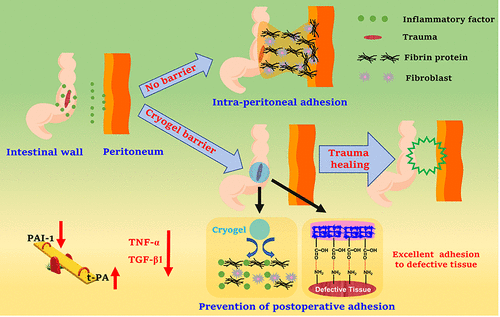当前位置:
X-MOL 学术
›
Biomacromolecules
›
论文详情
Our official English website, www.x-mol.net, welcomes your feedback! (Note: you will need to create a separate account there.)
Physically Cross-Linked Hyaluronan-Based Ultrasoft Cryogel Prepared by Freeze–Thaw Technique as a Barrier for Prevention of Postoperative Adhesions
Biomacromolecules ( IF 6.2 ) Pub Date : 2021-09-09 , DOI: 10.1021/acs.biomac.1c00878 Zhixiang Cai 1 , Yanmei Tang 2, 3, 4, 5 , Yue Wei 1 , Pengguang Wang 1 , Hongbin Zhang 1
Biomacromolecules ( IF 6.2 ) Pub Date : 2021-09-09 , DOI: 10.1021/acs.biomac.1c00878 Zhixiang Cai 1 , Yanmei Tang 2, 3, 4, 5 , Yue Wei 1 , Pengguang Wang 1 , Hongbin Zhang 1
Affiliation

|
Postsurgical peritoneal adhesions are a common and serious postoperative complication after various peritoneal surgeries, such as pelvic and abdominal surgery. Various studies have shown that peritoneal adhesions can be minimized or prevented by physical anti-adhesion barriers, including membranes, knits, and hydrogels. Hydrogels have attracted great attention in preventing peritoneal adhesions because the dimensional architecture of hydrogels is similar to that of the native extracellular matrix. However, chemical cross-linkers had to be used in the preparation of chemical hydrogels, which may have problems in cytotoxicity or unwanted side effects. This fact prompts us to create alternative cross-linking methods for the development of biocompatible hydrogels as physical barriers. Herein, we report a physically cross-linked flexible hyaluronan (HA) cryogel prepared via a freeze–thaw technique as a novel anti-adhesion biomaterial for completely preventing postsurgical peritoneal adhesions. In vitro studies demonstrated that this physically cross-linked HA cryogel exhibited excellent biocompatibility, the inherently desirable biocompatibility and functionality of HA being integrally retained as much as possible. Intriguingly, the rheological properties and appropriate biodegradability of the cryogels were readily tailored and tunable by way of the gelation process. In vivo assessments suggested that the cryogel, as a physical barrier, satisfactorily prevented fibroblast penetration and attachment between the injured tissues and nearby normal organs. Furthermore, the molecular mechanism studies revealed that the HA cryogel could prevent peritoneal adhesion by inhibiting inflammatory response and modulation of the fibrinolytic system. Our results show that HA ultrasoft cryogel is a promising clinical candidate for prolonged adhesion prevention.
中文翻译:

冻融技术制备的基于物理交联透明质酸的超软冷冻凝胶作为预防术后粘连的屏障
术后腹膜粘连是盆腔、腹部等各种腹膜手术后常见且严重的术后并发症。各种研究表明,可以通过物理抗粘连屏障(包括膜、针织物和水凝胶)最大限度地减少或预防腹膜粘连。水凝胶在预防腹膜粘连方面引起了极大的关注,因为水凝胶的尺寸结构与天然细胞外基质的尺寸结构相似。然而,化学交联剂必须用于制备化学水凝胶,这可能存在细胞毒性或不良副作用方面的问题。这一事实促使我们创造替代交联方法来开发生物相容性水凝胶作为物理屏障。在此处,通过冻融技术作为一种新型抗粘连生物材料,可完全预防术后腹膜粘连。体外研究表明,这种物理交联的 HA 冷冻凝胶表现出优异的生物相容性,尽可能完整地保留 HA 固有的理想生物相容性和功能。有趣的是,冷冻凝胶的流变特性和适当的生物降解性很容易通过凝胶化过程进行定制和调整。体内评估表明,冷冻凝胶作为一种物理屏障,可以令人满意地防止成纤维细胞穿透和附着在受伤组织和附近正常器官之间。此外,分子机制研究表明,HA冷冻凝胶可以通过抑制炎症反应和调节纤溶系统来预防腹膜粘连。我们的研究结果表明,HA 超软冷冻凝胶是一种很有前途的临床候选物,可用于长期预防粘连。
更新日期:2021-09-09
中文翻译:

冻融技术制备的基于物理交联透明质酸的超软冷冻凝胶作为预防术后粘连的屏障
术后腹膜粘连是盆腔、腹部等各种腹膜手术后常见且严重的术后并发症。各种研究表明,可以通过物理抗粘连屏障(包括膜、针织物和水凝胶)最大限度地减少或预防腹膜粘连。水凝胶在预防腹膜粘连方面引起了极大的关注,因为水凝胶的尺寸结构与天然细胞外基质的尺寸结构相似。然而,化学交联剂必须用于制备化学水凝胶,这可能存在细胞毒性或不良副作用方面的问题。这一事实促使我们创造替代交联方法来开发生物相容性水凝胶作为物理屏障。在此处,通过冻融技术作为一种新型抗粘连生物材料,可完全预防术后腹膜粘连。体外研究表明,这种物理交联的 HA 冷冻凝胶表现出优异的生物相容性,尽可能完整地保留 HA 固有的理想生物相容性和功能。有趣的是,冷冻凝胶的流变特性和适当的生物降解性很容易通过凝胶化过程进行定制和调整。体内评估表明,冷冻凝胶作为一种物理屏障,可以令人满意地防止成纤维细胞穿透和附着在受伤组织和附近正常器官之间。此外,分子机制研究表明,HA冷冻凝胶可以通过抑制炎症反应和调节纤溶系统来预防腹膜粘连。我们的研究结果表明,HA 超软冷冻凝胶是一种很有前途的临床候选物,可用于长期预防粘连。



























 京公网安备 11010802027423号
京公网安备 11010802027423号